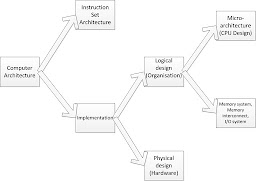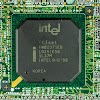Components of a Microcomputer

A standard microcomputer consists
of a microprocessor (CPU), buses, memory, parallel input/output, serial
input/output, programmable I/O interrupt, and direct memory access DMA.
Central
Processing Unit (CPU)

The central processing unit (CPU)
is the “brain” of the computer and is responsible for accepting data from input
devices, processing the data into information, and transferring the information
to memory and output devices. The CPU is organized
into the following three major
sections:
1. Arithmetic logic unit (ALU)
2. Control unit
3. Registers
The function of the arithmetic
logic unit (ALU) is to perform arithmetic operations such as addition,
subtraction, division, and multiplication and logic operations such as AND, OR,
and NOT. The function of the control unit is to control input/output devices,
generate control signals to the other components of the computer such as read
and write signals, and perform instruction execution. Information is moved from
memory to the registers; the registers then pass the information to the ALU for
logic and arithmetic operations.
CPU
Buses
When more than one wire carries
the same type of information, it is called a bus. The most common buses inside
a microcomputer are the address bus, the data bus, and the control bus.
32-Bit Versus 64-Bit CPU
The size of register plays an
important role in the performance of CPU. A 32-bit processor means it can
perform operations on 32-bit data; therefore, the size of registers is 32 bits
and ALU also performs 32-bit operations. A 64-bit CPU performs operation in
64-bit data; therefore, it contains 64-bit register and 64-bit ALU. Most
desktop and server computers are using AMD and Intel processors; they might use
32 bits or 64 bits. Intel and AMD processor use the same architecture; this means
a program in computer with Intel processor can run on a computer with AMD
processor.
CPU
Technology
There are two types of technology
used for designing CPU and they are called CISC and RIS. CISC (Complex
Instruction Set Computer) In 1978, Intel developed the 8086 microprocessor
chip. The 8086 was designed to process a 16-bit data word; it had no instruction for floating point operations.
At the present time, the Pentium processes 32-bit and 64-bit words, and it can
process floating point instructions. Intel designed the Pentium processor in
such a way that it can execute programs written for earlier 80*86 processors. The
characteristics of 80 _ 86 are called complex instruction set computers (CISC),
which include instructions for earlier Intel processors. Another CISC processor
is VAX 11/780, which can execute programs for the PDP-11 computer. The CISC
processor contains many instructions with different addressing modes, for
example, the VAX 11/780 has more than 300 instructions with 16 different address
modes.
Intel
Microprocessor Family
Intel designs and manufactures
microprocessors for microcomputers. Each processor has a number or name, which
is used by the computer designer to access the information provided by the
manufacturer of the processor. Intel microprocessor IC numbers and names are
8088, 80,286, 80,386, 80,486, Pentium, Pentium II, Pentium III, and Pentium IV
which they called IA-86 (Intel architecture-86). Recently Intel and HP
developed a new processor called Itanium which is a 64-bit processor, which is
described later in this chapter.
Disk
Controller
The disk controller moves the
disk drive head, reads, and/or writes data. Today, there are two types of disk
controllers: IDE (integrated disk electronics) and SCSI (small computer systems
interface). Integrated Disk Electronics (IDE). An IDE disk drive is connected
to the ISA bus with a flat ribbon cable. The IDE disk controller supports two
hard disks, each with a 528-megabyte capacity. In 1994, hard disk drive vendors
introduced EIDE (extended IDE) which supports four devices, such as hard disks,
tape drives, CD-ROM devices, and larger hard disk drives. The EIDE has two
connectors. Each cable is connected to the EIDE controller and can support two
hard disk drives with a capacity of up to 250 GB. EIDE is used in
IBM-compatible computers.
Microcomputer
Bus
There are currently a number of different computer buses on the market that are designed for microcomputers. Some of the computer BUS are ISA, MCA, EISA, VESA PCI, FireWire, USB, and PCI Express. Universal serial bus (USB) and PC Express are covered in more detail because they are more advanced than other buses.
Type
of microcomputer Bus
1. ISA Bus
The industry standard architecture (ISA) bus was introduced by IBM for the IBM PC using an 8088 microprocessor. The ISA bus has an 8-bit data bus and 20 address lines at a clock speed of 8 MHz. The PC AT type uses the 80,286 processor which has a 16-bit data bus and 24-bit address lines and is compatible with the PC.
2.Micro channel Architecture Bus
The micro channel architecture (MCA) bus was introduced by IBM in 1987 for its PS/2 microcomputer. The MCA bus is a 32-bit bus that can transfer four bytes of data at a time and runs at a 10 MHz clock speed. It also supports 16-bit data transfer and has 32-bit address lines. Micro channel architecture was so expensive the non-IBM vendors developed a comparable but less expensive solution called the EISA bus.
3. EISA Bus
The extended ISA (EISA) bus is a 32-bit bus that also supports 8- and 16-bit data transfer bus architectures. EISA runs at 8-MHz clock speeds and has 32-bit address lines.
4. VESA Bus
The video electronics standard association (VESA) bus, which is also called a video local bus (VL-BUS), is a standard interface between the computer and its expansion. As applications became more graphically intensive, the VESA bus was introduced to maximize throughput of video graphics memory. The VESA bus provides fast data flow between stations and can transfer up to 132 Mbps.
5. PCI Bus
The peripheral component interconnect (PCI) bus was developed by Intel Corporation. PCI bus technology includes a 32-/64-bit bus that runs at a 33/66 MHz clock speed. PCI offers many advantages for connections to hubs, routers, and network interface cards (NIC). In particular, PCI provides more bandwidth: up to 1 gigabit per second as needed by these hardware components. The PCI bus was designed to improve the bandwidth and decrease latency in computer systems. Current versions of the PCI bus support data rates of 1056 Mbps and can be upgraded to 4224 Mbps. The PCI bus can support up to 16 slots or devices in the motherboard. Most suppliers of ATM (asynchronous transfer mode) and 100BaseT NICs offer a PCI interface for their products. The PCI bus can be expanded to support a 64-bit data bus. us.
6. Universal Serial BUS (USB)
The universal serial
bus (USB) is a computer serial bus which enables users to connect peripherals
such as the mouse, keyboard, modem, CD-ROM, scanner, and printer, to the outside of a computer without
any configuration. Personal computers equipped with USB will allow the user to
connect peripherals to the computer, and the computer will automatically be
configured as the devices are attached to it. This means that a USB has the
capability to detect when a device has been added or removed from a PC. USB is
a true plug-and-play bus.
7. PCI
Express Bus
PCI express was introduced in
mid-1990 with 33 MHz frequency, and during the time the speed of BUS was
increased to 66 MHz. Due to new development in networking technology such as
Gigabit Ethernet and I/O devices that demand more bandwidth, there is a need
for a new bus technology with higher bandwidth. The PCI express was approved by
Special Interest Group in 2002, and chipset starts shipping in 2004. The
PCI express has the following features:
• PCI express is point-to-point
connection between devices.
• PCI express is a serial bus.
• PCI express uses pocket and
layer architecture.
• Compatible with PCI bus through
software.
• End-to-end link data integrity
(error detection).
• Isochronous data transfer.
• Select able bandwidth.














0 Comments